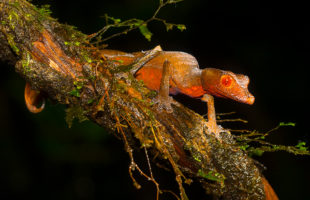A two-storey red brick house with wooden doors and unglazed windows: a perfectly common sight in the central highlands of Madagascar. Almost all houses between the many yellow shining rice fields are built of red bricks and plastered with clay. With the Europeans also the knowledge about the production of bricks came to Madagascar in the 19th century. It is …
LesenMasika sipa
The last nomads
Madagascar has many different ethnic groups, and most of them still have original lifestyles, ancient traditions and centuries of deep-rooted faith. But a small group of Madagascans live even closer to nature and the lives of their ancestors: The Mikea, Madagascar’s last nomads. The small ethnic group of about 1000 people gets its name from the forest of the same …
LesenThe Satanic Leaf-Tailed Gecko
A small but very pretty gecko lives well camouflaged in the rainforests of the central east and southeast in the highlands of Madagascar: the Satanic Leaf-Tailed Gecko (Uroplatus phantasticus). The little guy got his name from biologist George Boulenger as early as 1888. The Belgian first described the species and chose the name because of the bizarre appearance of the …
LesenAnja Community Reserve
Anja Community Reserve: The reserve is named after the Anja Miray Association, its nickname is “Anja Park”. Because of its rocky character, the reserve is also known as “Rocky Park”. Location: About 13 km south of Ambalavao is the Anja Community Reserve in the Haute-Matsiatra region. It can be easily reached by car via the RN7, it is only half …
LesenTaxibrousse
Taxibrousse is the famous French name for the Malagasy bush taxi, which is a kind of share taxi for overland drives. For most Malagasy people, these busses are the only opportunity to travel longer distances for affordable prices, and thus they are part of the Malagasy sense of life. Several companies run Taxibrousses. Often the vehicles, old Mazda, Peugeot or …
LesenThe old Baobab of Mahajanga
Mahajanga (formerly French Majunga) is the capital of the province of the same name in northwestern Madagascar and with more than 250,000 inhabitants one of the largest cities in Madagascar. It is located directly at the entrance of Bombetoka Bay. The oldest Baobab in Madagascar stands directly on the coast, just a few meters from the water. Legend has it …
LesenProtected area Loky Manambato
Loky Manambato: This reserve is named after the two rivers that flow through it: Loky and Manambato. It is home to the last lemurs of its kind. In this remote part of Madagascar, you are rewarded with fantastic photo opportunities and unique experiences that may not be possible anymore in a few years. Location: Daraina, a small village directly within …
LesenThe big market of Toamasina
Toamasina (Tamatave) is the largest city on Madagascar’s east coast, and is home to the country’s largest port. This makes it the largest transshipment centre for spices, food and everyday goods in the area. The city has two markets, the small market (Bazary Kely) directly at the station and the large market (Bazary Be) between Rue Admiral Billard and Rue …
LesenMarojejy National Park
Marojejy: Marojejy National Park is one of the most biodiverse and beautiful in Madagascar, but also one of the most difficult to travel to. An “advanced paradise”! The Malagasy words maro and jejy have various meanings, including “many stones” and “much rain”, but also “many animals” and “many ancestral spirits”. Location: Marojejy National Park is located in the northeast of …
LesenThe royal hill of Ambohimanga
About 25 kilometres northeast of Antananarivo in the central highlands of Madagascar lays the royal hill of Ambohimanga. The road there is relatively good, but due to the very chaotic and dense traffic in Tana, a drive to Ambohimanga alone can easily take one to three hours depending on chosen day time. If you want to visit Ambohimanga, it is …
Lesen MADAMAGAZINE Your Magazine about Madagascar
MADAMAGAZINE Your Magazine about Madagascar










